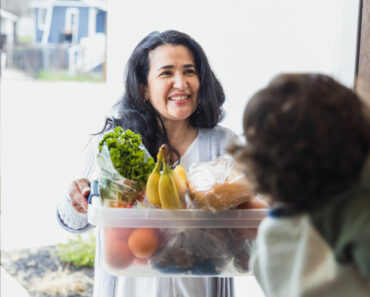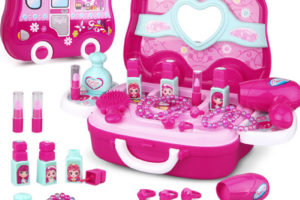Chances are, you know someone who has COVID right now. In fact, it may feel like everyone you know is testing positive.
We’re now in the sixth wave of COVID-19, and this one is promising to be just as disruptive as the others.
“Even if you’re feeling done with COVID, everything is going to be impacted in the next month if we don’t do anything, including education and healthcare,” says Janine McCready, an infectious diseases specialist at Michael Garron Hospital in Toronto.
While it might feel like there’s nothing you can do as this wave crashes over us, there are still ways to protect your family from getting it (or getting it again) and limiting spread can also help schools stay open and minimize disruption to the health care system.
It’s also important to know what to do if your kid does get COVID during this wave. Here’s what parents need to know about the BA.2, the Omicron subvariant that’s fueling this sixth wave.
What are the symptoms of BA.2?
Compared to previous variants, upper respiratory issues are more common with BA.2, says Christos Karatzios, a paediatric infectious diseases specialist at the Montreal Children’s Hospital. “We’re seeing congestion, sore throats, hoarseness and loss of voice—not as much taste and smell loss as with previous variants,” he says. Coughing and fever are still fairly common.
McCready says that, anecdotally, she’s heard of gastrointestinal symptoms occurring a lot more in both kids and adults with BA.2, and that in kids under two, doctors are seeing a lot of croup spurred by COVID. “Sometimes they need a little help breathing [with oxygen],” she says. “Really, it’s a spectrum—sometimes it’s just a runny nose, some are just very tired.”
Doctors are also seeing lesions like in hand, foot and mouth disease, including sores on the palms, the soles and in the mouth.
McCready suggests parents test their children for COVID if they have any of these symptoms, with or without better-known red flags like coughing, a runny nose or a fever.
How serious is BA.2 for kids?
Generally speaking, BA.2 is associated with a smaller percentage of severe outcomes than previous variants of COVID-19 like Delta, but is far more transmissible than any previous variant. While research is still being reviewed, early findings suggest that the dominant BA.2 variant is 30 to 40 percent more contagious than the original Omicron. The emerging variant (XE), which is a hybrid of both BA.1 and BA.2, is an additional 10 percent more contagious than BA.2.
This evolution of variants with higher transmissibility has resulted in surging case numbers in many communities—”a tsunami rather than a wave,” says Karatzios. While the chance your child will get a severe infection from COVID is still low, it does happen, and child hospitalizations are at concerning levels, especially for those too young to be vaccinated. In Ontario, as of April 12, 75 kids aged four and under, were hospitalized with COVID in the last 14 days. Comparatively, only 15 kids aged 5 to 11 were hospitalized in the same timeframe. According to an official at CHEO, Ottawa’s paediatric health centre, emergency room visits are at a historic high, with about 65 percent of visits being for COVID-like symptoms.
“When more people get sick, even if the percentage of people going into hospital is less, it raises the overall number of people needing hospitalization,” says Karatzios.
How protected are fully-vaccinated kids?
When vaccines first rolled out, they offered a very high level of protection from both infection and severe outcomes (in some cases, over 95 percent). Many adults and teens were able to get vaccinated in this timeframe, but by the time vaccines were approved for kids under age 12, we were dealing with the early stages of Omicron. With these new variants, our protection against infection is significantly reduced (efficacy against current variants is approximately 50 to 65 percent, according to Dr. Karatzios) and the farther away from our last immunization date we get, the less protection we have.
Fortunately, being vaccinated still offers very strong protection against severe outcomes from COVID-19. So if your kid got COVID recently even though they were vaccinated, that doesn’t mean the vaccine didn’t work—it very likely reduced the severity of the illness.
Kids who got COVID recently also now have additional immune protection for some time—McCready isn’t seeing much reinfection before the two month mark, while Karatzios estimates that immunity may last several months. This immunity is stronger if your child is also vaccinated.
How worried should I be about the sixth wave?
Unvaccinated and immunocompromised individuals remain the most likely to experience severe outcomes or require hospitalization, says McCready. But that’s not the only measure we need to look at.
Higher case numbers put a massive strain on the healthcare system—particularly as healthcare workers themselves get sick—and the education system faces similar challenges as more teachers and support staff are infected.
“Most healthcare workers are fairly young, and they have children in society and in schools,” McCready says. “If they get sick, we’re going to see the impact.”
We also don’t know much about the long term impact of COVID on kids yet, and there’s also the increased risk of MIS-C in children who have had the virus—a condition where multiple areas of the body suffer from inflammation (although vaccination reduces this risk considerably).
Karatzios, for one, is worried that another crisis is going to hit the health care system after COVID-19 in the form of long haul symptoms and related illnesses like diabetes, cardiac issues and dementia. “It being survivable is not the point. There’s a lot more to it that’s been forgotten.”
Should kids be wearing masks in school right now?
“There is more COVID around now than in almost any other part of the pandemic,” says McCready. Masks reduce the likelihood of transmission and in addition to providing personal protection, they help protect those around you. “Unless your child has a significant issue that interferes with their functioning, the benefits of wearing a mask significantly outweigh the risk.”
Another benefit of masking is that it helps maintain consistency at school. “Wearing a mask is going to help keep your kids in school and keep their regular teacher there,” says McCready.
My kids are sick—what do I do?
Rapid tests are less sensitive to Omicron variants of COVID (including BA.2 and XE), new research suggests, which means you can test negative even if you have the virus. Knowing this, you should stay home and isolate if you have symptoms—even if you’ve tested negative.
It may help to swab the back of your throat as well as your nasal cavity, and to test again after several days. You are more likely to get a positive test when your viral load is at its highest, which can be several days after symptoms begin.
To treat COVID symptoms at home, give your kid plenty of fluids, let them rest as much as possible and give them Advil or Tylenol as needed. A saline nasal spray may relieve congestion and discomfort, and lozenges may help older kids with a sore throat. If you have questions or concerns about your child’s condition, call your family doctor immediately.
Opening windows can help improve ventilation in your home and may be helpful if not all family members are affected. Air purifiers with good filters, like a HEPA filter, can also be beneficial. If some members of your household are feeling healthy and testing negative, they may want to wear a mask in common areas or isolate themselves from others to avoid infection. Alternatively, you can isolate the one family member who has COVID in an effort to stop it from spreading. While this won’t work with very young kids (and parents often don’t have the option), it may be possible for some families.
Some provinces only require a five-day isolation period, but McCready says that often isn’t long enough to ensure you’re no longer contagious. She recommends staying home longer if you continue to have symptoms. A positive rapid-test result also means you’re still contagious.
Dealing with pandemic fatigue
Despite us all wishing it so, the pandemic isn’t over. And while it’s perfectly reasonable to want to “live with COVID” going forward, that doesn’t mean abandoning all preventative measures or throwing caution to the wind.
“There’s a way of living with COVID by making adjustments to our normal activities that will make everything more safe for everyone, and then when we get cases, it’s less disruptive,” says McCready says. “We need to do basic things like improving ventilation, masking when cases are high and staying home when sick.
“I’m very disheartened to see us lifting the white flag,” says Karatzios. “I understand that everybody is tired, but this isn’t going to go away by letting it rip through society.” Instead, he worries, we’ll see more and more mutations as the virus circulates unimpeded.
“The public messaging has been garbled. But BA.2 is not the common cold and letting it rip through society will not create herd immunity.”
By normalizing protections in high-risk settings and staying home while sick, we can minimize risk and disruption going forward. And yes, it will help us finally reach the end of the pandemic.

































